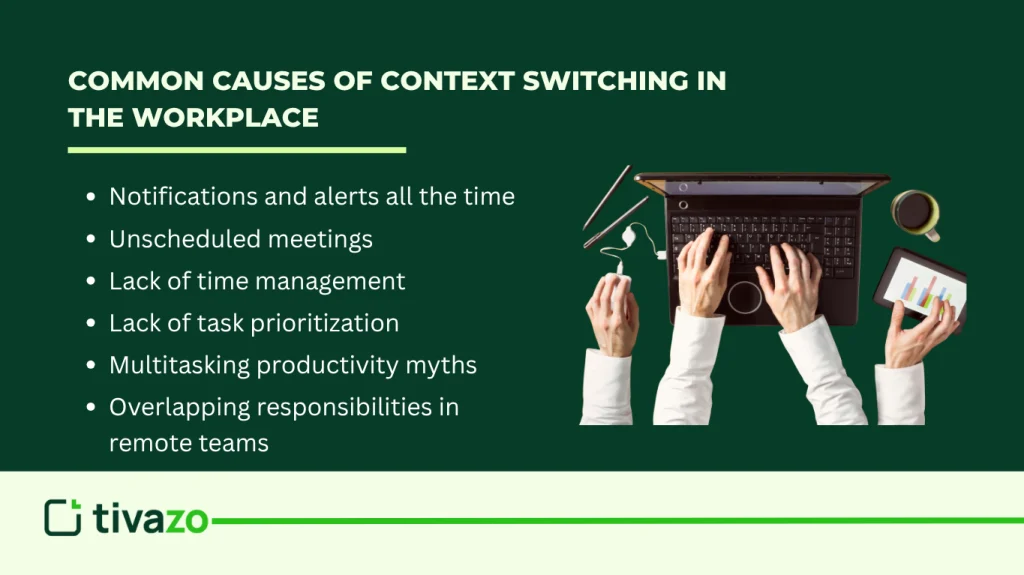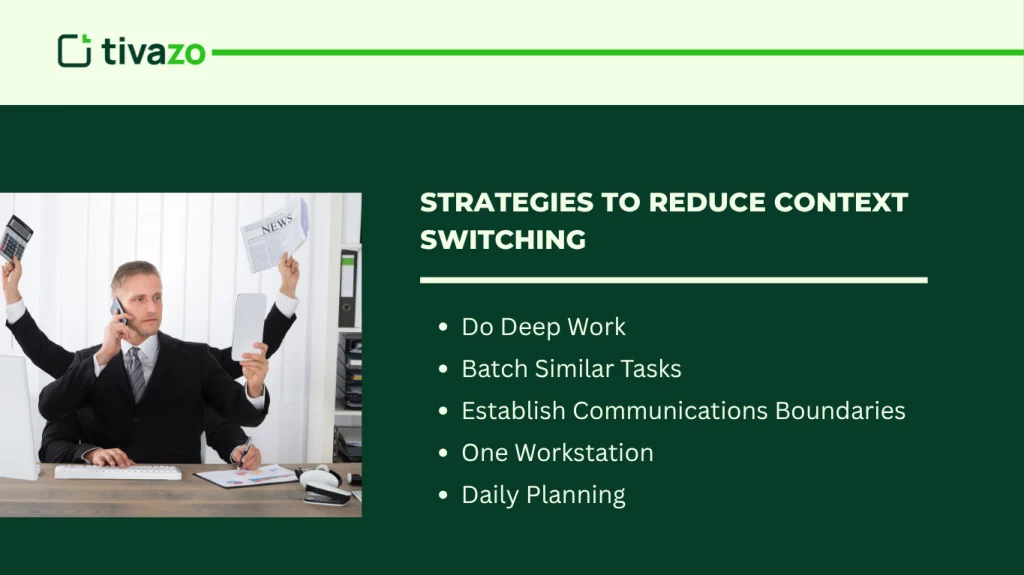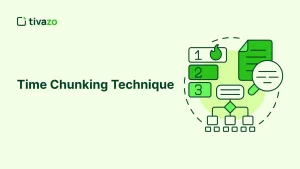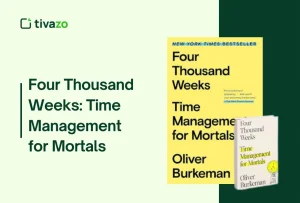Have you ever experienced mental fatigue when you did not get much accomplished in spite of a hectic day of work in progress? YOU may be a victim of context switching. Context switching is the process of switching between one task, tool, or mental model during your day. Although it might appear that multitasking, or switching tasks, is somehow efficient, research has repeatedly indicated that multitasking can have a marked negative impact on how productive you are, as well as your level of mental fatigue.
This guide will touch on what context switching is all about, its outcomes, why it should not be confused with multitasking, and some quick, practical ideas that can be used to reduce context switching. Being a remote employee, a leader of a team of people, or any busy entrepreneur, you could all use mastering how to focus on your work and reduce distractions, as it will help you improve your work productivity radically.
What Is Context Switching?
Context switching occurs when your mind goes from one task to another. Context switching, unlike multitasking productivity, usually considers quick changes in tasks carried out one after another. As an example, write a report, respond to a Slack message, check email, and then get back to your report. Every such switch consumes mental power.
Research indicates that it takes more than 20 minutes to regain concentration even after a switch. Consider what this does to your career when you are changing assignments several times every hour. Such changes in direction result in attention residue, and this brings about a further interruption of concentration.
The Psychology Behind Context Switching
Human brains are not made to be frequently interrupted. Context switching causes mental fatigue and further leads to burnout. The phenomena of leftover thoughts (from Task A) that follow you into Task B are described by the term, attention residue. This remnant hampers our capacity to concentrate properly on emerging tasks.
The decrease in focus that is attributed to context switching is based in the field of cognitive psychology because the brain experiences a stoppage in performance, discharging one context and downloading another. That repetitive task burns energy and escalates the rate of error. It also results in dissatisfaction, which is because one feels like nothing is being done deeply.
The Impact of Context Switching on Productivity
When you are continually changing the thing that you are doing:
- You cut down on deep work time
- You raise decision fatigue
- You prolong the duration of completion of time
- You end up being more prone to errors
Context switching and prevention of burnout are interconnected. Incessant breaks and mental multitasking result in stress. Such pressure in the long term may result in total withdrawal.
Studies have also established that productivity is enhanced by reducing context switching. Companies and individuals who minimize it state how much they have improved their focus, clarity, and performance.
Common Causes of Context Switching in the Workplace

Notifications and alerts all the time
Email, Slack, phone alerts, and other digital tools disrupt your concentration all the time. These distractions will remove you from deep work and will make your brain refocus, and you will lose productivity, and attention residue will be experienced.
Unscheduled meetings
Unexpected or last-minute meetings stall the flow of work. They tend to interrupt the employees in the middle of a task, and as such, it becomes difficult to concentrate thereafter.
Lack of time management
It is simple to jump around errands without a good, organized schedule of the day. Failure to block time properly or no time schedule results in frequent switching and low work efficiency.
Lack of task prioritization
As everything appears to be urgent, workers do not accomplish much with the rearrangement of low- and high-priority jobs. This continuous reprioritization leads to further mental strain and a lack of focus on progress.
Multitasking productivity myths
Many people tend to think that multitasking increases productivity, but the fact is that attention is broken, and the quality of the task is impaired by it. Getting faith in this myth helps in a high instance of context switching.
Overlapping responsibilities in remote teams
With the remote arrangements, functions and roles can become confused, and workers can end up performing various duties. Such crossover culminates in switching and can result in mental fatigue and poor productivity.
Context switching is an even more important issue in remote working environments. Remote work is even more distracting due to its digital tech: there is a constant stream of tabs and pings and the tendency to switch among several apps, such as Slack, Notion, Zoom, and email.
Tools to Avoid Context Switching
The following are some tools and techniques that would assist in the reduction of context switching:
- Time blocking tools (e.g., Google Calendar, Sunsama): Schedule concentrated work time.
- Task management apps (e.g., Todoist, ClickUp): Manage tasks.
- Notification blockers (e.g., Freedom, Cold Turkey): Remove distractions.
- Communication protocol: Establish communication rules so that there is a time and method of communication.
- Pomodoro timers: Promote focus Hours and breaks in between.
- Tivazo: Monitor the focus levels, detect distractions, and acquire information on how time is utilized in any aspect of work.
These technological tools are able to facilitate a culture of deep work and tap off attention after products.
Strategies to Reduce Context Switching

1. Do Deep Work:
Devote a few time slots to distraction-free, concentrated work. Based on the principles of Cal Newport, deep work will enable you to become as intensively concentrated as possible by avoiding all the distractions and going in-depth with a single cognitively demanding activity.
2. Batch Similar Tasks:
Do similar tasks, such as replying to emails, calling, or doing other simple administrative tasks, at specific periods of time. This reduces the burden on the mind and spends more time on the brain in a certain context.
3. Establish Communications Boundaries:
Formulate precise guidelines on how and when you communicate with your team. Switch off unnecessary notifications and set times to check email or chat in a team. This prevents side interruptions and maintains your focus.
4. One Workstation:
Also, there should be reduced digital hopping by consolidation of your tools and platforms. Integrations or unified dashboards, regardless of how they are done, keep you working in a single interface, thus preserving flow and minimizing the friction associated with switching apps or systems.
5. Daily Planning:
Start every day with a plan of action. Produce a set of priorities, schedule everything out and calculate exactly where interruption might set in. This forecasting limits last-minute decision-making and change of context.
6. Delegation:
Look out for tasks that can be delegated to other people, and in particular those that are not your main area of focus. The main benefit of delegating is not only that it frees up your mental bandwidth but also that it is putting you into high-impact activities that you have to give full attention.
Managing Context Switching in Remote Teams
Teams that operate remotely have exceptional difficulties. There are no physical limits or even natural pauses, so employees tend to believe that they should always be present.
In order to coordinate context switching within remote teams:
- Designate work-time to be used in sync communication
- Take advantage of the asynchronous communication tools
- Promote standup meetings and planning on the daily basis
- There should be no permanent necessities in expectations
Working remotely must inspire independence, not increase the level of distraction. The efficient remote working process depends on the ability to maintain context switching.
How to Reduce Context Switching at Work
There is action you can take to restrict context switching:
- Design a structured workday: Permanent timetable, with time slots, marking certain activities. Having a routine will take away the tedious effects of decision fatigue and allow one to be able to work with concentration.
- Minimize the number of meetings: Evaluate the need of meetings. Reduced wasteful meetings mean more time to devote to focusing as well as effortless accomplishment of the activities.
- Switch off your email alerts: You will lose focus in the face of continuous alerts to check your inbox. Assign certain hours to read and answer the email rather than respond immediately.
- To-do lists: Always have a list of the tasks to be done in a day, and never switch to other unrelated stuff. Ticking the things that are done gives a feeling of accomplishment and purity.
- Activate a visual task board such as Trello or KanbanFlow: this will enable you to view your working process in an overview, so there is no mental burden of remembering. They are also proving to keep tasks in order and limit impulsive jumps.
Remember: There is a cost to every switch. Increase performance by avoiding context switching as much as possible.
Final Thoughts: Regaining Focus and Control
Focus management is a skill that has to be mastered in the contemporary work environment. Knowing the costs of context switching, you can start organizing your day and workflows more purposefully. You will be more satisfied and less stressed as you will get more done significantly faster with improved time management, distraction management, and clever delegation.
Do not allow switching and mental fatigue to ruin your performance. The road to greater efficiency and clarity of work starts with identifying the foe: context switching. Then apply tools, routines, and concentration strategies to get rid of it.




